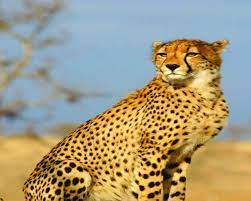Madhya Pradesh is the only state in the country where one can hear the purrs of Cheetahs. It has been possible because of the cheetah project which has given a different identity to the state. On the 72nd birthday of Prime Minister Narendra Modi, eight cheetahs – five males and three females – were brought from Namibia and released in Kuno National Park, Sheopur district, Madhya Pradesh. In the second phase, 12 cheetahs, comprising seven males and five females, were brought from South Africa. Special arrangements have been made for settling these cheetahs.
Once cheetahs were found in large areas of the Indian peninsula, but their number has declined because of hunting and for want of habitations.
At the beginning of the 20th century, it was considered that cheetahs had been extinct. The Government of India had been making efforts to bring cheetahs to the country and thus, it has made some rules.
Cheetah maintains ecological balance
Cheetah is a predator that plays an important role in maintaining ecological balance. Its rehabilitation will control the population of herbivorous animals, like deer, blue bulls and bison. Else, those animals will destroy grass and other plants.
Cheetahs will also draw a large number of tourists from different parts of the country and abroad. So, it will boost tourism. Cheetahs are the most beautiful and the most popular of all the big cats. The cheetahs will also attract those who take interest in wildlife and nature.
To boost researches
Rehabilitation of cheetahs will increase scope for research to preserve them. Wildlife experts will have an opportunity to understand the behaviour and lifestyle of this predator, which will also help to make a strategy to keep them in a better way.
Symbolic importance
Cheetahs are an essential part of Indian culture and mythological stories. So, there may be some symbolic significance to bring them back to the country. Their rehabilitation and conservation indicate that the nation is committed to preserving its traditions.
Proper habitation required
The biggest challenge is to find a proper habitation for cheetahs that need a vast area covered with grass. Nevertheless, such areas have reduced in India because of increasing human settlements and agricultural activities. Therefore, it is necessary to find a proper settlement for cheetahs, which may be highly expensive.
Conflict with other predators: The cheetah is not the only predator in areas where efforts are being made to reintroduce them. The presence of predators such as tigers and leopards in their areas can lead to competition for prey between them, which can create a situation of conflict between them.
Conflict with other predators
The cheetahs are not the only predators in the areas where they have been kept. Since there are other predators like tigers and leopards in those areas, there may be clashes among them for survival, which is going to be a major challenge for foresters and wildlife experts.
Genetic diversity
The cheetahs being brought to the country must have been accustomed to captive life in their native lands. Since they are living in captivity, there may be a decrease in their genetic diversity, which may adversely affect their health and ultimately their survival.
Costly affair
Resettling cheetahs in India is going to be very expensive. For this, sufficient financial resources are needed to create apt conditions for their breeding in the protected area and monitor their actions. It is not going to be an easy task for a country like India to make such settlements, since the country has many other priorities.
Two cheetahs die in one month
The government, the forest department and the wildlife experts are worried about the death of two cheetahs at Kuno National Park in a month. On March 27, Sasha, one of the eight cheetahs brought from Namibia, died of kidney failure. Another cheetah, Uday, died on April 23.
The organisations working for wildlife conservation have raised questions over the death of two cheetahs. They say some of the cheetahs are not able to adapt themselves to the environment at Kuno.
The management of the national park says a large number of small and large animals, like deer, chital, sambar and rabbits have been released in the park for food of cheetahs.
On the other hand, the wildlife organisations claim that the Kuno National Park authorities have failed to make proper food available to cheetahs.
New worries about cheetahs
New challenges are emerging for cheetahs at Kuno, say forest officials. Principal chief conservator of forests (wildlife) Jasveer Singh Chouhan says arrangements have been made for 20-25 cheetahs in the national park.
Although two cheetahs have died, their population has increased to 22 because of the birth of four cubs.
Therefore, when more cubs are born, the capacity of the park to accommodate them will exceed, he says.
According to Chouhan, the forest department has written a letter to the Central Government saying that if the number of cubs increases, the cheetahs should be shifted to other places.
Before bringing cheetahs to Kuno, the government had examined the possibilities of settling these big cats at Nauradehi forest sanctuary at Madhya Pradesh and Bhainsrodgarh wildlife complex in Rajasthan.
In India, the last cheetah was hunted in 1947 in Koria district, Chhattisgarh, say wildlife experts. Nonetheless, it was officially declared extinct in 1952. Nearly after 70 years of waiting, the country has found cheetahs last year.
Cheetah cubs at Kuno
On the one hand, the wildlife experts are worried about the death of two cheetahs, but on the other hand, they are excited about the birth of four cubs at the national park last month. A female cheetah, brought from Namibia, mothered these four cubs. A team of experts, looking after these cubs, say they are born in the country, though after 70 years, yet, they are healthy.
A senior official dealing with the Cheetah conservation project says the birth of four cubs at Kuno indicates that the environment in the area is favourable to cheetahs. Thus, they are fast adapting to it.
Now, 22 cheetahs
in Kuno
Twenty cheetahs were brought to the national park. Eight were released on September 17 last year, and 12 were set free on February 18 this year.
A female cheetah Sasha died on March 27 this year. Therefore, their number has declined to 19. The number shot up to 23 after the birth of four cubs. Meanwhile, on April 23, a male cheetah Uday died, reducing the number of cheetahs to 22.
Conclusion
There are advantages and disadvantages of reintroducing cheetahs in the country. However, it is very difficult. There is no doubt that bringing cheetahs to India has ecological and symbolic importance. Still, the huge expenses the exercise involves is enormous, and one cannot deny that.
The government has to take a policy decision keeping all stakeholders in the project in mind. It should also be ensured that the long-term conservation and survival of these big cats should be a priority.

The author, a retired Director General of Police and former IPS 1986 MP cadre with a PhD in botany, writes on law enforcement, education, wildlife, and environment for various media houses. He’s also pursuing post-graduation in astrology.























